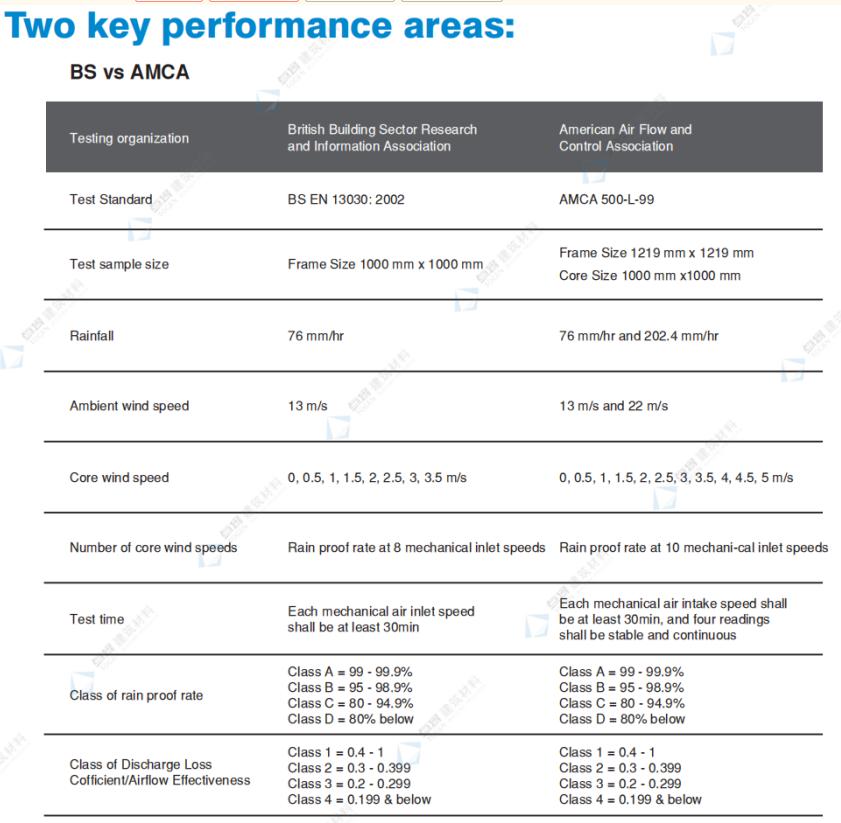BS vs AMCA: Comparing Two Key Louver Performance Standards
Why Testing Standards Matter
When specifying architectural louvers for buildings, performance is not just about appearance — it is about tested protection, airflow efficiency, and reliability under real-world conditions. Two of the most widely referenced international standards are:
• BS EN 13030:2002 (British Standard, developed by BSRIA)
• AMCA 500-L:1999 (American Standard, developed by the Air Movement and Control Association)
Understanding the similarities and differences between these standards is critical for engineers and architects when selecting weather louvers or performance louvers for global projects.
Test Setup and Conditions
• Sample Size:
• BS EN 13030 uses a 1000 × 1000 mm frame.
• AMCA 500-L uses a 1219 × 1219 mm frame with a 1000 × 1000 mm core size.
• Rainfall Rate:
• BS EN 13030: 76 mm/hr.
• AMCA 500-L: 76 mm/hr and 202.4 mm/hr, allowing more severe rain simulations.
• Ambient Wind Speed:
• Both standards test at 13 m/s, but AMCA also includes 22 m/s, representing harsher weather conditions.
Wind Speed & Test Procedure
• Core Wind Speeds:
• BS: 0 to 3.5 m/s (8 increments).
• AMCA: 0 to 5 m/s (10 increments), testing at more airflow rates.
• Test Time:
• BS: Each airflow speed tested for at least 30 minutes.
• AMCA: Each airflow speed tested for 30 minutes with four stable readings required, ensuring more consistent data.
Performance Classifications
• Rain Penetration Classes:
Both standards classify rain rejection efficiency into Class A to D:
• Class A: 99–99.9% rain rejection
• Class D: Below 80% rain rejection
• Discharge Loss Coefficient (Airflow Effectiveness):
Both use Class 1 to 4 categories:
• Class 1: 0.4 – 1.0 (best airflow efficiency)
• Class 4: ≤ 0.199 (poor efficiency, higher pressure drop)
Key Differences Between BS and AMCA
1. Rainfall Simulation:
• AMCA tests with both moderate and extreme rainfall rates (202.4 mm/hr), while BS only considers 76 mm/hr.
2. Wind Speed Range:
• AMCA includes higher wind speed conditions (up to 22 m/s and 5 m/s airflow), making it more stringent in severe weather testing.
3. Measurement Accuracy:
• AMCA requires multiple stable readings for validation, while BS accepts a single 30-minute test.
Why This Matters for Project Design
Choosing a louver tested under AMCA 500-L ensures proven performance under harsher conditions, particularly for regions with tropical storms, hurricanes, or monsoons. On the other hand, BS EN 13030 provides a widely recognized European standard that remains highly relevant for typical building projects in moderate climates.
Ultimately, specifying louvers with both BS and AMCA certification offers the highest confidence for international projects, ensuring compliance with multiple regions and delivering proven reliability.
Both BS EN 13030 and AMCA 500-L are valuable standards for assessing louver airflow and rain resistance performance. While BS provides strong guidance for European projects, AMCA offers more rigorous testing for extreme weather scenarios.
At Vanman, we supply AMCA-certified performance louvers and weather louvers tested to both BS and AMCA standards — ensuring your building achieves the right balance of airflow, protection, and energy efficiency.

